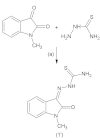Inhibition of Chikungunya Virus Replication by 1-[(2-Methylbenzimidazol-1-yl) Methyl]-2-Oxo-Indolin-3-ylidene] Amino] Thiourea(MBZM-N-IBT)
- PMID: 26843462
- PMCID: PMC4740769
- DOI: 10.1038/srep20122
Inhibition of Chikungunya Virus Replication by 1-[(2-Methylbenzimidazol-1-yl) Methyl]-2-Oxo-Indolin-3-ylidene] Amino] Thiourea(MBZM-N-IBT)
Abstract
Chikungunya virus (CHIKV) infection is one of the most challenging human Arboviral infections with global significance and without any specific antiviral. In this investigation, 1-[(2-methylbenzimidazol-1-yl) methyl]-2-oxo-indolin-3-ylidene] amino] thiourea (MBZM-N-IBT) was synthesised as a molecular hybrid of 2-methyl benzimidazole and isatin-β-thiosemicarbazone and its anti-CHIKV property was evaluated. The release of infectious virus particles was calculated by plaque assay, expression profile of viral RNA was estimated by RT-PCR and viral protein profiles were assessed by Western blot and FACS analyses. The safety index of MBZM-N-IBT was found to be >21. The CHIKV infectious viral particle formation was abrogated around 76.02% by MBZM-N-IBT during infection in mammalian system and the viral RNA synthesis was reduced by 65.53% and 23.71% for nsP2 and E1 respectively. Surprisingly, the viral protein levels were reduced by 97% for both nsP2 and E2. In the time-of-addition experiment it abrogated viral infection at early as well as late phase of viral life cycle, which indicates about multiple mechanisms for its anti-CHIKV action. In silico analysis justified development of MBZM-N-IBT with good affinities for potential target proteins of CHIKV and related virus. With predictions of good drug-likeness property, it shows potential of a drug candidate which needs further experimental validation.
Figures








Similar articles
-
Inhibition of herpes simplex virus-1 infection by MBZM-N-IBT: in silico and in vitro studies.Virol J. 2021 May 26;18(1):103. doi: 10.1186/s12985-021-01581-5. Virol J. 2021. PMID: 34039377 Free PMC article.
-
MBZM-N-IBT, a Novel Small Molecule, Restricts Chikungunya Virus Infection by Targeting nsP2 Protease Activity In Vitro, In Vivo, and Ex Vivo.Antimicrob Agents Chemother. 2022 Jul 19;66(7):e0046322. doi: 10.1128/aac.00463-22. Epub 2022 Jun 29. Antimicrob Agents Chemother. 2022. PMID: 35766508 Free PMC article.
-
Heat shock protein 90 positively regulates Chikungunya virus replication by stabilizing viral non-structural protein nsP2 during infection.PLoS One. 2014 Jun 24;9(6):e100531. doi: 10.1371/journal.pone.0100531. eCollection 2014. PLoS One. 2014. PMID: 24959709 Free PMC article.
-
Arctigenin from Arctium lappa L. inhibits chikungunya virus by affecting its entry and replication.Phytomedicine. 2024 Jun;128:155491. doi: 10.1016/j.phymed.2024.155491. Epub 2024 Feb 27. Phytomedicine. 2024. PMID: 38489894
-
Computer-Aided Structure Based Drug Design Approaches for the Discovery of New Anti-CHIKV Agents.Curr Comput Aided Drug Des. 2017 Nov 10;13(4):346-361. doi: 10.2174/1573409913666170309145308. Curr Comput Aided Drug Des. 2017. PMID: 28294048 Review.
Cited by
-
Small-Molecule Inhibitors of Chikungunya Virus: Mechanisms of Action and Antiviral Drug Resistance.Antimicrob Agents Chemother. 2020 Nov 17;64(12):e01788-20. doi: 10.1128/AAC.01788-20. Print 2020 Nov 17. Antimicrob Agents Chemother. 2020. PMID: 32928738 Free PMC article. Review.
-
Salicylic Acid Conjugate of Telmisartan Inhibits Chikungunya Virus Infection and Inflammation.ACS Omega. 2023 Dec 21;9(1):146-156. doi: 10.1021/acsomega.3c00763. eCollection 2024 Jan 9. ACS Omega. 2023. PMID: 38222605 Free PMC article.
-
From Structure to Function: Isatin Derivatives as a Promising Class of Antiviral Agents.Curr Drug Targets. 2025;26(7):470-488. doi: 10.2174/0113894501352560250115054156. Curr Drug Targets. 2025. PMID: 39878104 Review.
-
In Silico Drug Repurposing Uncovered the Antiviral Potential of the Antiparasitic Drug Oxibendazole Against the Chikungunya Virus.ACS Omega. 2024 Jun 13;9(25):27632-27642. doi: 10.1021/acsomega.4c03417. eCollection 2024 Jun 25. ACS Omega. 2024. PMID: 38947813 Free PMC article.
-
SELEX based aptamers with diagnostic and entry inhibitor therapeutic potential for SARS-CoV-2.Sci Rep. 2023 Sep 4;13(1):14560. doi: 10.1038/s41598-023-41885-w. Sci Rep. 2023. PMID: 37666993 Free PMC article.
References
-
- Robinson M. C. An epidemic of virus disease in Southern Province, Tanganyika Territory, in 1952-53. I. Clinical features. Trans R Soc Trop Med Hyg 49, 28–32 (1955). - PubMed
-
- Lam S. K. et al. Chikungunya infection–an emerging disease in Malaysia. Southeast Asian J Trop Med Public Health 32, 447–451 (2001). - PubMed
-
- Mahendradas P. et al. Ocular manifestations associated with chikungunya. Ophthalmology 115, 287–291 (2008). - PubMed
-
- Chatterjee S. N., Chakravarti S. K., Mitra A. C. & Sarkar J. K. Virological investigation of cases with neurological complications during the outbreak of haemorrhagic fever in Calcutta. J Indian Med Assoc 45, 314–316 (1965). - PubMed
Publication types
MeSH terms
Substances
LinkOut - more resources
Full Text Sources
Other Literature Sources
Medical

